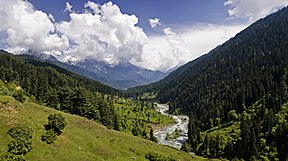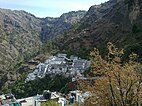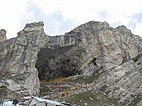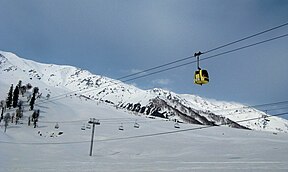
Back جامو وكشمير (منطقة اتحادية) Arabic जम्मू अउर कश्मीर AWA जम्मू अउरी काश्मीर Bihari জম্মু ও কাশ্মীর (কেন্দ্রশাসিত অঞ্চল) Bengali/Bangla Jammu und Kashmir (Unionsterritorium) German Territorio de Jammu y Cachemira Spanish جامو و کشمیر Persian Jammu-et-Cachemire (territoire de l'Union) French Jammu an Kaschmir FRR Jammu agus an Chaismír (críoch aontais) Irish
Jammu and Kashmir | |
|---|---|
 Interactive map of Jammu and Kashmir | |
![A map of the disputed Kashmir region with the two Indian-administered union territories Jammu and Kashmir and Ladakh shown in tan.[3]](http://upload.wikimedia.org/wikipedia/commons/thumb/8/84/Kashmir_region._LOC_2003626427_-_showing_sub-regions_administered_by_different_countries.jpg/250px-Kashmir_region._LOC_2003626427_-_showing_sub-regions_administered_by_different_countries.jpg) | |
| Coordinates: 33°5′24″N 74°47′24″E / 33.09000°N 74.79000°E | |
| Administering state | India |
| Union territory | 31 October 2019 |
| Capitals | Srinagar (May–October) Jammu (November–April)[4] |
| Districts | 20 |
| Government | |
| • Body | Government of Jammu and Kashmir |
| • Lieutenant Governor | Manoj Sinha |
| • National Parliament | Parliament of India : Lok Sabha (5) |
| • High Court | High Court of Jammu and Kashmir and Ladakh |
| Area | |
| • Total | 42,241 km2 (16,309 sq mi) |
| Highest elevation | 7,135 m (23,409 ft) |
| Lowest elevation | 247 m (810 ft) |
| Population (2011)[6] | |
| • Total | 12,267,013 |
| • Density | 290/km2 (750/sq mi) |
| Languages | |
| • Official | Kashmiri, Dogri, Urdu, Hindi, English[7][8] |
| • Spoken | Kashmiri, Gojri, Pahari, Punjabi, Bhadarwahi, Sarazi, Khowar, Shina, Burushaski, Bateri[16] |
| Time zone | UTC+05:30 (IST) |
| ISO 3166 code | IN-JK |
| Vehicle registration | JK |
| HDI (2018) | |
| Website | www |
Jammu and Kashmir[b] is a region administered by India as a union territory[1] and consists of the southern portion of the larger Kashmir region, which has been the subject of a dispute between India and Pakistan since 1947 and between India and China since 1959.[3] The Line of Control separates Jammu and Kashmir from the Pakistani-administered territories of Azad Kashmir and Gilgit-Baltistan in the west and north. It lies to the north of the Indian states of Himachal Pradesh and Punjab and to the west of Ladakh which is administered by India as a union territory.[2]
Provisions for the formation of the union territory of Jammu and Kashmir were contained within the Jammu and Kashmir Reorganisation Act, 2019, which was passed by both houses of the Parliament of India in August 2019. The act re-constituted the former state of Jammu and Kashmir into two union territories, one being Jammu and Kashmir and the other being Ladakh, with effect from 31 October 2019.[18]
- ^ a b Akhtar, Rais; Kirk, William (22 March 2021), "Jammu and Kashmir", Encyclopaedia Britannica, Encyclopædia Britannica, Inc., retrieved 2 April 2022,
The union territory is part of the larger region of Kashmir, which has been the subject of dispute between India, Pakistan, and China since the partition of the subcontinent in 1947. ... The territory that India administered on its side of the line, which contained both Jammu (the seat of the Dogra dynasty) and the Vale of Kashmir, took on the name Jammu and Kashmir. However, both India and Pakistan have continued to claim the entire Kashmir region
- ^ a b Briticannica, Eds Encycl. (1 March 2021), "Ladakh", Encyclopaedia Britannica, Encyclopædia Britannica, Inc., retrieved 2 April 2022,
Ladakh, large area of the northern and eastern Kashmir region, northwestern Indian subcontinent. Administratively, Ladakh is divided between Pakistan (northwest), as part of Gilgit-Baltistan, and India (southeast), as part of Ladakh union territory (until October 31, 2019, part of Jammu and Kashmir state); in addition, China administers portions of northeastern Ladakh.
- ^ a b The application of the term "administered" to the various regions of Kashmir and a mention of the Kashmir dispute is supported by the tertiary sources (a) through (e), reflecting due weight in the coverage. Although "controlled" and "held" are also applied neutrally to the names of the disputants or to the regions administered by them, as evidenced in sources (h) through (i) below, "held" is also considered politicised usage, as is the term "occupied," (see (j) below).
(a) Kashmir, region Indian subcontinent, Encyclopaedia Britannica, retrieved 15 August 2019 (subscription required) Quote: "Kashmir, region of the northwestern Indian subcontinent ... has been the subject of dispute between India and Pakistan since the partition of the Indian subcontinent in 1947. The northern and western portions are administered by Pakistan and comprise three areas: Azad Kashmir, Gilgit, and Baltistan, the last two being part of a territory called the Northern Areas. Administered by India are the southern and southeastern portions, which constitute the state of Jammu and Kashmir but are slated to be split into two union territories.";
(b) Pletcher, Kenneth, Aksai Chin, Plateau Region, Asia, Encyclopaedia Britannica, retrieved 16 August 2019 (subscription required) Quote: "Aksai Chin, Chinese (Pinyin) Aksayqin, portion of the Kashmir region, at the northernmost extent of the Indian subcontinent in south-central Asia. It constitutes nearly all the territory of the Chinese-administered sector of Kashmir that is claimed by India to be part of the Ladakh area of Jammu and Kashmir state.";
(c) "Kashmir", Encyclopedia Americana, Scholastic Library Publishing, 2006, p. 328, ISBN 978-0-7172-0139-6 C. E Bosworth, University of Manchester Quote: "KASHMIR, kash'mer, the northernmost region of the Indian subcontinent, administered partlv by India, partly by Pakistan, and partly by China. The region has been the subject of a bitter dispute between India and Pakistan since they became independent in 1947";
(d) Osmańczyk, Edmund Jan (2003), Encyclopedia of the United Nations and International Agreements: G to M, Taylor & Francis, pp. 1191–, ISBN 978-0-415-93922-5 Quote: "Jammu and Kashmir: Territory in northwestern India, subject to a dispute between India and Pakistan. It has borders with Pakistan and China."
(e) Talbot, Ian (2016), A History of Modern South Asia: Politics, States, Diasporas, Yale University Press, pp. 28–29, ISBN 978-0-300-19694-8 Quote: "We move from a disputed international border to a dotted line on the map that represents a military border not recognized in international law. The line of control separates the Indian and Pakistani administered areas of the former Princely State of Jammu and Kashmir.";
(f) Skutsch, Carl (2015) [2007], "China: Border War with India, 1962", in Ciment, James (ed.), Encyclopedia of Conflicts Since World War II (2nd ed.), London and New York: Routledge, p. 573, ISBN 978-0-7656-8005-1,The situation between the two nations was complicated by the 1957–1959 uprising by Tibetans against Chinese rule. Refugees poured across the Indian border, and the Indian public was outraged. Any compromise with China on the border issue became impossible. Similarly, China was offended that India had given political asylum to the Dalai Lama when he fled across the border in March 1959. In late 1959, there were shots fired between border patrols operating along both the ill-defined McMahon Line and in the Aksai Chin.
(g) Clary, Christopher (2022), The Difficult Politics of Peace: Rivalry in Modern South Asia, Oxford and New York: Oxford University Press, p. 109, ISBN 978-0-19-763840-8,Territorial Dispute: The situation along the Sino-Indian frontier continued to worsen. In late July (1959), an Indian reconnaissance patrol was blocked, "apprehended," and eventually expelled after three weeks in custody at the hands of a larger Chinese force near Khurnak Fort in Aksai Chin. ... Circumstances worsened further in October 1959, when a major class at Kongka Pass in eastern Ladakh led to nine dead and ten captured Indian border personnel, making it by far the most serious Sino-Indian class since India's independence.
(h) Bose, Sumantra (2009), Kashmir: Roots of Conflict, Paths to Peace, Harvard University Press, pp. 294, 291, 293, ISBN 978-0-674-02855-5 Quote: "J&K: Jammu and Kashmir. The former princely state that is the subject of the Kashmir dispute. Besides IJK (Indian-controlled Jammu and Kashmir. The larger and more populous part of the former princely state. It has a population of slightly over 10 million, and comprises three regions: Kashmir Valley, Jammu, and Ladakh.) and AJK ('Azad" (Free) Jammu and Kashmir. The more populous part of Pakistani-controlled J&K, with a population of approximately 2.5 million.), it includes the sparsely populated "Northern Areas" of Gilgit and Baltistan, remote mountainous regions which are directly administered, unlike AJK, by the Pakistani central authorities, and some high-altitude uninhabitable tracts under Chinese control."
(i) Fisher, Michael H. (2018), An Environmental History of India: From Earliest Times to the Twenty-First Century, Cambridge University Press, p. 166, ISBN 978-1-107-11162-2 Quote: "Kashmir's identity remains hotly disputed with a UN-supervised "Line of Control" still separating Pakistani-held Azad ("Free") Kashmir from Indian-held Kashmir.";
(j) Snedden, Christopher (2015), Understanding Kashmir and Kashmiris, Oxford University Press, p. 10, ISBN 978-1-84904-621-3 Quote:"Some politicised terms also are used to describe parts of J&K. These terms include the words 'occupied' and 'held'." - ^ The Hindu Net Desk (8 May 2017). "What is the Darbar Move in J&K all about?". The Hindu. Archived from the original on 10 November 2017. Retrieved 23 February 2019.
- ^ Singh, Jogindar (1975). "Saser Kangri". The American Alpine Journal: 67. Archived from the original on 14 February 2019. Retrieved 14 February 2019. pdf of original pages
- ^ Singh, Vijaita (29 February 2020). "Only J&K will use 2011 Census for delimitation". The Hindu. Retrieved 6 November 2020.
- ^ "The Jammu and Kashmir Official Languages Act, 2020" (PDF). The Gazette of India. 27 September 2020. Archived from the original (PDF) on 19 October 2020. Retrieved 27 September 2020.
- ^ "Parliament passes JK Official Languages Bill, 2020". Rising Kashmir. 23 September 2020. Archived from the original on 24 September 2020. Retrieved 23 September 2020.
- ^ "Pakistan's "Burushaski" Language Finds New Relatives". National Public Radio. Retrieved 6 August 2019.
- ^ Khan, N. (6 August 2012). The Parchment of Kashmir: History, Society, and Polity. Springer. p. 184. ISBN 978-1-137-02958-4. Archived from the original on 23 February 2019. Retrieved 23 February 2019.
- ^ "Bhadrawahi". Ethnologue: Languages of the World. Dallas: SIL International. Retrieved 6 August 2019.
- ^ Bateri.
- ^ Simons, Gary F.; Fennig, Charles D. (2017). Ethnologue: Languages of the World, Twentieth Edition. Dallas: SIL International.
- ^ Crane, Robert I. (1956). Area Handbook on Jammu and Kashmir State. University of Chicago for the Human Relations Area Files. p. 179.
Shina is the most eastern of these languages and in some of its dialects such as the Brokpa of Dah and Hanu and the dialect of Dras, it impinges upon the area of the Sino-Tibetan language family and has been affected by Tibetan with an overlay of words and idioms.
- ^ Aggarwal, J. C.; Agrawal, S. P. (1995). Modern History of Jammu and Kashmir: Ancient times to Shimla Agreement. Concept Publishing Company. ISBN 978-81-7022-557-7. Archived from the original on 24 February 2019. Retrieved 23 February 2019.
- ^ [9][10][11][12][13][14][15]
- ^ Jones, Daniel (2003) [1917], Peter Roach; James Hartmann; Jane Setter (eds.), English Pronouncing Dictionary, Cambridge: Cambridge University Press, ISBN 978-3-12-539683-8
- ^ Cite error: The named reference
Gazette2was invoked but never defined (see the help page).
Cite error: There are <ref group=lower-alpha> tags or {{efn}} templates on this page, but the references will not show without a {{reflist|group=lower-alpha}} template or {{notelist}} template (see the help page).
© MMXXIII Rich X Search. We shall prevail. All rights reserved. Rich X Search





